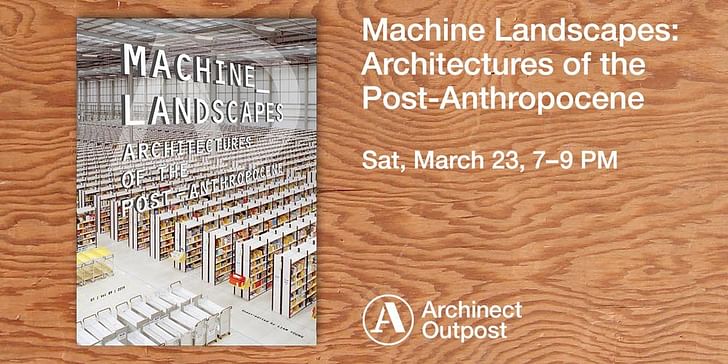

A significant number of buildings around the world are deliberately uninhabitable by humans. They are, however, designed absolutely towards the service of human needs. The unusual conditions of these buildings, including those of telecommunications networks, automated agriculture and data centers are explored in Machine Landscapes: Architectures of the Post-Anthropocene, a timely publication by Liam Young, the Australian-born architect operating in the spaces between design, fiction and futures, currently teaching at the Southern California Institute of Architecture (SCI-Arc).
Liam Young and Geoff Manaugh will present their thoughts on the book at Architect Outpost March 23rd at 7pm, followed by a book signing. Machine Landscapes can be preordered from Archinect Outpost here.
You can RSVP here to reserve your spot at the event.
It takes a lot to meet the demands of the average consumer today. The increasingly impossible standards of quality, convenience and economics expected by many of us has put untold pressures on companies to develop vast spaces for activities deemed too fast, dangerous and complicated for human hands and minds. And while many of us may live near a port, from which extraordinarily large infrastructures of shipping containers and gantry cranes paint even the smallest picture of the architectures of non-human space, there are vast landscapes out there that remain a total mystery to the laymen. How can those of us living in human-centered spaces make sense of those set up to both execute and invisibilize our requirements in the era of late capitalism?

Machine Landscapes: Architectures of the Post-Anthropocene, the newest issue of Architectural Design edited by Liam Young, intends to bring these exiled spaces to the center of conversation so that this important question can be addressed.
With contributions from the editor and other researchers of the subject — including Benjamin Bratton, Clare Lyster and Jesse LeCavalier — Machine Landscapes provides an atlas for discovering what has been designed to be undiscoverable.
Geoff Manaugh of BLDGBLOG fame contributed an essay on the contemporary processional routes of transportation facilities, focusing on Global Container Terminals in New Jersey at which, as Liam Young writes in its introduction, "shipping containers are moved about by an algorithmically controlled mechanical system, with humans intervening only remotely and for mere seconds at a time."
Without the encumbrance of human error, the coordination of Global Container Terminals can (and must) work with a greater efficiency than could ever be imagined in the cities to which it delivers. Reflecting on their seamless productivity in Manaugh's description might cause the reader some anguish; are bottlenecking traffic and pointless meetings, by contrast, not the plights of the average human worker?
Jesse LeCavalier argues that the practices of robotically-organized warehouses, which reconfigure their inventory at such grand scales, are inherently architectural (in the image above, the small orange robots, known as robotic drive units, or RDUs, are seen organizing stacks of inventory for their next phase of distribution).
Might the reader see the architectures of Machine Landscapes as the fruitless pitting of utopian dreams against the immeasurable force of capitalism?
It is hard not to see the success of this warehouse's operation as an abysmal consequence of Cedric Price's research on flexible architecture for his signature Fun Palace proposal that began in 1959. The Kiva system employed in the essay is exactly what Price had dreamt of — without, of course, the people to enjoy it. Might the reader see the architectures of Machine Landscapes as the fruitless pitting of utopian dreams against the immeasurable force of capitalism?
Near the end of the issue, Liam Young interviews Paul Inglis, the supervising art director of Bladerunner 2049, a movie designed with the appearance of human abandonment. While the set design is indeed dystopian, it maintains a level of terrifying authenticity through a careful balance of present situations and future speculations.
The architecture described in Machine Landscapes is undoubtedly terrifying, partially given the inhumanity of its scales and speed, and partially because it is entirely shaped by the demands of our baser instincts as consumers.
"You are always going to have your fictional environment feel more real if it is encoded with some kind of experience that we know today," says Inglis. Might the reader read the desolate landscapes of Blade Runner 2049 with anxiety precisely because of the felt ambiguity of the machine landscapes that currently exist out there in the generally unknown?
The architecture described in Machine Landscapes is undoubtedly terrifying, partially given the inhumanity of its scales and speed, and partially because it is entirely shaped by the demands of our baser instincts as consumers. Might our confrontation with them, in lyrical essays and breathtaking photography, cause us to question how our actions shape spaces we may never encounter in person?
Liam Young and Geoff Manaugh will present their thoughts on the book at Architect Outpost March 23rd at 7pm, followed by a book signing. Machine Landscapes can be preordered from Archinect Outpost here.
You can RSVP here to reserve your spot at the event.
2 Comments
“Great share!”
I recommend Allan Sekula and Noël Burch's The Forgotten Space. Here is a fifteen minutes long gist of it on youtube. You can watch the whole film in its full version for a couple of bucks with fantastic photography by the artists. The late capitalism creeps into global labor, laying the conditions of its own demise while turning the world into a certain dystopia.
Block this user
Are you sure you want to block this user and hide all related comments throughout the site?
Archinect
This is your first comment on Archinect. Your comment will be visible once approved.